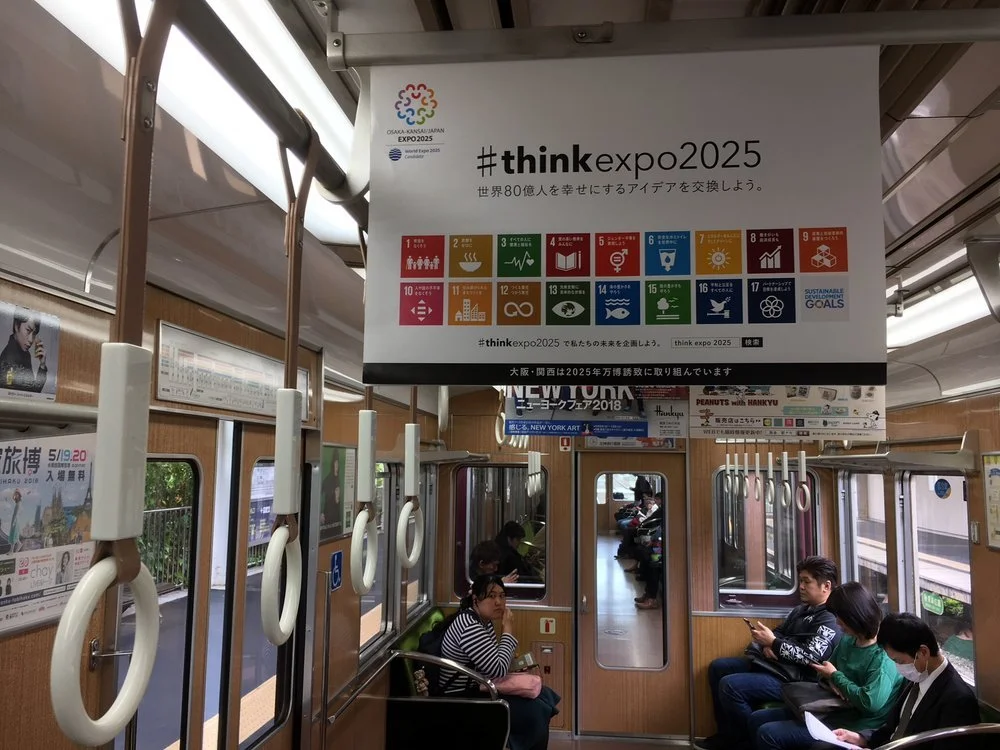Pleasant Surprise in Osaka
When I was visiting my elderly father in Osaka, Japan in May, I noticed the posters promoting Osaka’s candidacy for the World Expo 2025 inside and outside of trains and all over train stations. The World Expo was held in Osaka in 1970 when Japan was enjoying phenomenal economic growth. The Expo ‘70 was a huge financial and public relations success, drawing over 64 million visitors to Osaka during the 6-month period.
Now the government of Osaka is bidding to bring back the 2nd Expo to Osaka in 2025 hoping to draw the attention of the world to the region, thus revitalizing the economy. Two other cities are in the running: Baku, Azerbaijan and Ekaterinburg, Russia. The winning host city will be announced in November.
Just like the last few Olympic Games that have become so extravagant and expensive, the costs to host such an international event have recently surpassed the economic benefits coming out of it. I am one of the many people who aren’t convinced by Osaka’s optimism for huge economic benefit, so I wasn’t paying much attention to the campaign until one of the posters caught my attention. It had those 17 Sustainable Development Goals (the “SDGs”) on it and made me look into what Osaka’s candidacy is all about.
May 2018 poster for Expo 2025 in a Hankyu train in Osaka
As you know, the UN General Assembly adopted the 2030 Agenda for Sustainable Development which includes 17 SDGs in September 2015. Building on the principle of “leaving no one behind”, the new Agenda emphasizes a holistic approach to achieving sustainable development for all. Those 17 SDGs include End Poverty, End Hunger, Good Education and Gender Equality and so on.
The website of Osaka for the candidacy, https://www.expo2025-osaka-japan.jp/en/, says achieving a society meeting all 17 SDGs is one of the 2 themes of the Expo ’25. The 17 SDGs are to be achieved by 2030 and they want the Expo ‘25 to be a lab to showcase and share new technologies and innovative ideas for the meeting (or at least getting close to meeting) the 17 goals.
The other theme is to achieve a Japanese society based on the “Strategic Society 5.0”. According to a Japanese government paper, “Society 5.0” is where physical space and cyberspace are seamlessly connected through IT networks, by advancing innovation through the fourth industrial (information) revolution (e.g., AI, IoT, big data, robots). These efforts would strengthen the resilience of the economy by raising potential growth. The priority area includes Health (e.g., utilization of AI, IoT, big data, robots), Transportation (e.g., unmanned travelling) and FinTech (e.g., regulatory reform).
Japan has a shrinking and ageing population. “Japan’s population of 127 million is forecast to shrink by about one-third in the next five decades. The proportion of over-64-year-olds — currently about a quarter — is expected to reach 38 percent in that time frame”[1]. Strategic Society 5.0 is envisioned in efforts to deal with such reality in near future. Because Japan has been a homogenous society, people would rather rely on robots than get human help from outside by encouraging immigration. Promoting advancements in IT, Health and Transportation would benefit the Japanese people directly, but exporting such innovations would bring economic benefits to the country which hasn’t seen much economic growth in the last decade or so.
You & I who are in the Sustainability field know what SDGs are, but my family, friends and acquaintances in Japan have never heard of the SDGs and have no idea what they are. Japanese people in general live very comfortable and rather insular lives. Topics related to climate change have rarely come up in my conversations with my family and friends because they have been so far spared from the negative effects of climate change. (It is true that some areas of Japan have started to experience torrential rainfalls in recent years.) They are far more concerned about the ageing population, stagnant economy, earthquakes and Fukushima. The UN SDGs are just too far removed from their lives.
I don’t know if Osaka will be selected in November and get a real economic boost from the Expo ’25. But, one good thing coming out of Osaka’s candidacy is that they are pushing and highlighting the SDGs in their promotional material for the next 6 months so that more Japanese people or visitors to Japan would be exposed to the SDGs and maybe start thinking about what they could do to help create a more sustainable and compassionate world.
[1] Reynolds, I., Japan’s Shrinking Population, May 16, 2017, Bloomberg

